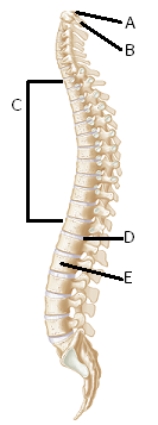A) The female pelvis is heavier.
B) The ilium is more flared in the female pelvis.
C) The ischial spines are further apart in the female pelvis.
D) The subpubic angle is 90 degrees or greater in the female pelvis.
E) The female pelvis is broader.
G) A) and C)
Correct Answer

verified
Correct Answer
verified
Multiple Choice
The pelvic girdle and lower limb are part of the
A) axial skeleton.
B) appendicular skeleton.
D) undefined
Correct Answer

verified
Correct Answer
verified
Multiple Choice
What condition is the failure of vertebral laminae to fuse?
A) lordosis
B) kyphosis
C) scoliosis
D) spina bifida
E) herniated disk
G) A) and D)
Correct Answer

verified
Correct Answer
verified
Multiple Choice
The sternum is part of the
A) axial skeleton.
B) appendicular skeleton.
D) undefined
Correct Answer

verified
Correct Answer
verified
Multiple Choice
Which of the following bones forms part of the lateral wall of the nasal cavity?
A) frontal
B) vomer
C) inferior nasal conchae
D) nasal
E) sphenoid
G) A) and E)
Correct Answer

verified
Correct Answer
verified
Multiple Choice
Dr. Jagasia informs a patient they have fractured the most anterior part of their vertebra. Which part is most likely affected?
A) body
B) lamina
C) spinous process
D) transverse process
E) vertebral arch
G) A) and C)
Correct Answer

verified
Correct Answer
verified
Multiple Choice
 -What does structure "A" represent?
-What does structure "A" represent?
A) atlas
B) axis
C) body of vertebra
D) intervertebral disk
E) thoracic region or curve
G) B) and E)
Correct Answer

verified
Correct Answer
verified
Multiple Choice
The loss of height that occurs with aging is due to compression of the
A) pelvic girdle.
B) vertebral arches.
C) vertebral bodies.
D) vertebral foramen.
E) intervertebral discs.
G) B) and C)
Correct Answer

verified
Correct Answer
verified
Multiple Choice
Which of the following bony features is mismatched with its description?
A) styloid process - point of articulation of mandible with skull
B) alveolar process - ridge containing the teeth
C) occipital condyles - articulation points between the skull and vertebral column
D) mandibular fossa - point of articulation of mandible with skull
E) crista galli - point of attachment of one of the meninges
G) A) and C)
Correct Answer

verified
Correct Answer
verified
Multiple Choice
Which of the following is false?
A) The wrist is the region between the forearm and the hand.
B) The olecranon process is located on the distal end of the ulna.
C) The distal end of the radius articulates with the ulna and the carpals.
D) Tendons and nerves pass through the carpal tunnel to enter the hand.
E) The radius is the most commonly fractured bone in people over 50.
G) B) and C)
Correct Answer

verified
Correct Answer
verified
Multiple Choice
The ribs articulate with the _____ vertebrae.
A) sacral
B) lumbar
C) thoracic
D) cervical
E) coccygeal
G) A) and B)
Correct Answer

verified
Correct Answer
verified
Multiple Choice
Which of the following is not a coxal bone?
A) ischium
B) femur
C) ilium
D) pubic
F) All of the above
Correct Answer

verified
Correct Answer
verified
Multiple Choice
A herniated disc occurs when
A) the body of a vertebra is fractured.
B) the covering of the spinal cord is torn.
C) there is a fracture of the vertebral arch.
D) there is protrusion of the nucleus pulposus.
E) spinal nerves are cut.
G) B) and D)
Correct Answer

verified
Correct Answer
verified
Multiple Choice
The skull bone that forms the chin is also the only bone connected to the skull by a freely moveable joint. This bone is the
A) hyoid.
B) mandible.
C) maxilla.
D) vomer.
E) mental bone.
G) A) and B)
Correct Answer

verified
Correct Answer
verified
Multiple Choice
Which anatomical term is correctly matched with its description?
A) condyle - a small, rounded bump
B) tuberosity - a flat, tongue-shaped process
C) fossa - adge
D) meatus - a tunnel
E) spine - a low ridge
G) A) and C)
Correct Answer

verified
Correct Answer
verified
Multiple Choice
The vertebral column is part of the
A) axial skeleton.
B) appendicular skeleton.
D) undefined
Correct Answer

verified
Correct Answer
verified
Multiple Choice
 -What does structure "C" represent?
-What does structure "C" represent?
A) atlas
B) axis
C) body of vertebra
D) intervertebral disk
E) thoracic region or curve
G) C) and D)
Correct Answer

verified
Correct Answer
verified
Multiple Choice
The olecranon process is found on the
A) ulna.
B) radius.
C) scapula.
D) humerus.
E) clavicle.
G) B) and C)
Correct Answer

verified
Correct Answer
verified
Multiple Choice
The humerus articulates with the radius at the
A) medial epicondyle.
B) lateral epicondyle.
C) capitulum.
D) radial fossa.
E) trochlea.
G) C) and E)
Correct Answer

verified
Correct Answer
verified
Multiple Choice
The posterior part of the vertebral arch is the
A) intervertebral disk.
B) vertebral foramen.
C) lamina.
D) intervertebral foramen.
E) spinous process.
G) A) and C)
Correct Answer

verified
Correct Answer
verified
Showing 61 - 80 of 173
Related Exams